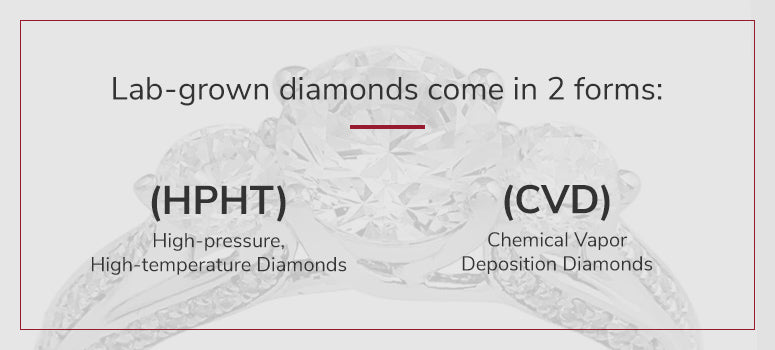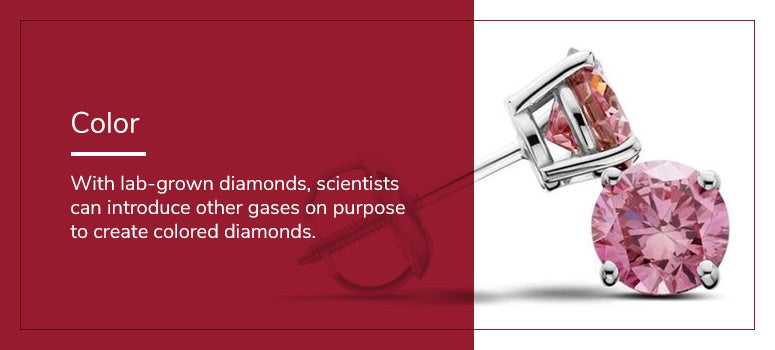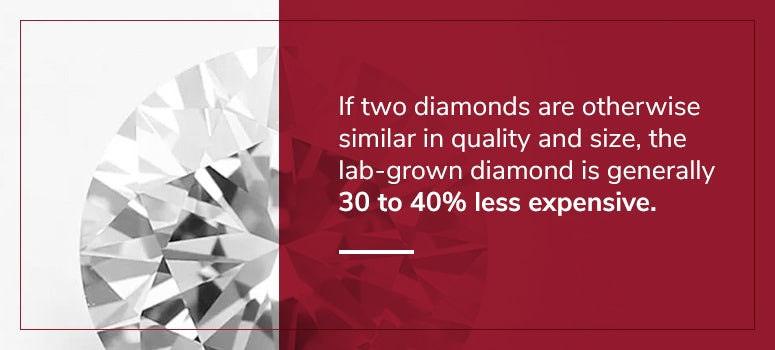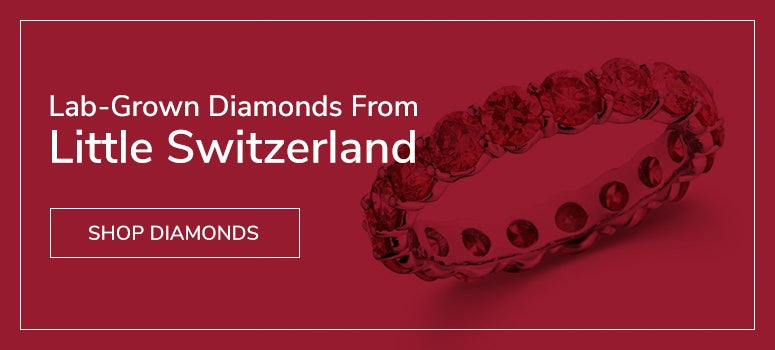Lab-Grown vs. Mined Diamonds

Diamonds are as popular as ever. They feature brilliantly in all types of jewelry, from elegant earrings and twinkling diamond necklaces to the sparkling, shiny rings that many newly engaged ladies love to show off. Surveys show that 80% of brides receive a diamond engagement ring before walking down the aisle. For jewelry to commemorate the biggest and best moments of your life, nothing beats a traditional diamond.
But have you ever thought about where the stones in a pair of diamond earrings or an engagement ring actually come from?
Some diamonds take the traditional route, forming deep in the earth over billions of years and remaining underground until humans come along and mine the earth for their crystals. But some diamonds take a very different, surprising route — they grow in a lab.
Lab-grown diamonds, or synthetic diamonds, and mined diamonds look identical, a diamond is a diamond no matter the source.This article provides helpful explanations of lab-grown vs. mined diamonds so you can choose the stones that are the best fit for you.
What Are Lab-Grown Diamonds and Mined Diamonds?
Lab-created vs. mined diamonds are both diamonds, but they have different life cycles and characteristics.
1. Mined Diamonds
Mined diamonds come from deep below ground, in the mantle of the earth. They formed there billions of years ago when pressure squeezed and compacted the element carbon into hard, crystallized diamond lumps. Eventually, volcanic activity forced those lumps closer to the earth's surface as rough diamonds. Diamonds are found in kimberlite, a type of igneous rock formation named after the South African town of Kimberley, where the discovery of a massive diamond in the nineteenth century led to a major diamond rush.
To extract mined diamonds, companies mine them out of the ground, setting up mining operations, digging the earth using specialized equipment and extracting the rough crystals.
2. Lab-Grown Diamonds
Lab-created diamonds, on the other hand, are grown in laboratories. Scientists researched and experimented for years to figure out how to do in the laboratory what the earth does organically. One significant difference between mined diamonds and lab-created diamonds is that, whereas organic diamonds are believed to be at least a billion years old and also take millions of years to form, lab-grown diamonds finish growing in a matter of weeks or months.

Lab-created diamonds come in two forms — high-pressure, high-temperature (HPHT) diamonds and chemical vapor deposition (CVD) diamonds. These designations refer to the way the diamonds form.
High-Pressure, High-Temperature Diamonds
To create HPHT diamonds, lab workers expose carbon to extremely high temperature and high pressure — similar to the conditions that produce mined diamonds beneath the earth's crust — to generate the crystals in the lab. This method, first used in a crude form by General Motors in the 1950s, produces many brown and yellow diamonds because of the number of gases that interact with the carbon. It is also expensive because of the energy and equipment it requires.
Chemical Vapor Deposition Diamonds
To create CVD diamonds, lab scientists start with a speck of crystal called a diamond seed and grow a larger crystal through layers of chemical deposits. This method pumps hydrocarbon gas — usually methane — into a vacuum chamber. It then uses microwaves to separate the gas molecules into hydrogen and carbon atoms. The carbon atoms deposit and build up on the diamond seed.
This method, which has been around for a decade or so, is less costly because it operates at lower temperatures and pressures and thus requires less energy and equipment. It can easily produce clear, colorless diamonds because it uses only hydrogen and carbon.
What Are the Physical Differences?
Whether you're talking about lab-grown diamonds or mined diamonds, no two diamonds are alike. Still, mined diamonds and lab-created diamonds differ in a few overarching ways.
Inclusions
Another physical difference between mined diamonds and lab-grown diamonds involves the imperfections of the diamond. Almost all diamonds have minuscule imperfections. Some jewelers might work their whole careers without seeing a diamond that would receive a flawless rating — small imperfections are that common.
Specialized laboratories, such as the American Gem Society (AGS) and the Gemological Institute of America (GIA), grade all certified diamonds, organic and lab-grown alike, on their flaws. They use a grading scale that runs from flawless to included, which additionally has three subcategories. Diamonds can contain two kinds of flaws — inclusions and blemishes.
Inclusions are imperfections located within the diamond. Blemishes are tiny cuts or scratches on the surface.
These Distinctions Are Microscopic
Knowing how to identify lab-grown diamonds takes professional training. Under special scientific equipment that magnifies diamonds' characteristics and imperfections to ten times their size, it is sometimes possible to tell whether a diamond is mined or lab-created. To the human eye, though, the features described above are invisible. The only way friends or strangers would know about these features is if you told them about your lab-created diamond — which you absolutely might, to showcase the beauty, elegance and conflict-free style of your stone and spread the word.
Do They Look and Shine Alike?
Mined diamonds and lab-grown diamonds are nearly indistinguishable visually, whether you're focusing on color, brightness or other visual characteristics.
1. Color
It is possible to compare mined and lab-grown diamonds in terms of color. Some mined diamonds contain different colors — commonly yellow —because of the geological conditions that surrounded them as they formed. As diamonds coalesced under heat and pressure beneath the earth's surface, small amounts of nitrogen often mix with the carbon as it compacted into diamonds. These trace amounts of nitrogen give some diamonds their yellow tinge. Colored diamonds beyond yellow or brown, however, are incredibly rare in nature.

With crafted diamonds, scientists can introduce other gases on purpose to create colored diamonds. If they introduce small amounts of nitrogen or boron into the growing process, they can create yellow, blue, green or even pink diamonds.
GIA, one of the primary gem laboratories, grades colored diamonds with this scale:
- Faint
- Very Light
- Light
- Fancy Light
- Fancy
- Fancy Intense
- Fancy Vivid
- Fancy Dark
- Fancy Deep
Fancy dark diamonds and fancy deep diamonds are the diamonds most sought after for their color.
2. Brightness, Fire and Scintillation
Diamond graders use different terms to describe the optical effect of diamonds' sparkly appearance. They evaluate diamonds on qualities termed brightness, fire and scintillation. Brightness or brilliance refers to the reflection of white light seen in the diamond. Fire refers to the flashes of color you can see on the face of a diamond when it moves in the light. Scintillation refers to the flashes of light you can see under the same circumstances, or to the eye-pleasing contrast between these areas of light and areas of dark. Lab-grown diamonds are no different from mined diamonds in this regard.
The specific cut of a diamond can be used to enhance these optical effects and make diamonds shine and sparkle with their characteristic spectacular luster. Both mined and lab-created diamonds come in a variety of different shapes and cuts — emerald, oval, radiant, princess and more.
Spot the Difference
Inexpensive diamond simulants like cubic zirconia and moissanite are composed of entirely different substances and do not possess diamonds' peerless luster and sparkle. Lab-grown diamonds, on the other hand, are made of the same element as mined diamonds — carbon — and have a nearly indistinguishable structure. They are also exceptionally durable — diamonds are one of the hardest materials on the planet, so both mined and lab-grown stones will last for decades and beyond in pristine condition.
Lab-grown diamonds look identical to mined diamonds to the naked eye. Each type of diamond sees its stones exist on a spectrum of clarity and color. Some mined diamonds are nearly flawless, and others contain small visible or visible imperfections — lab-mined diamonds are the same way.
Studies show that the pubic is increasingly catching on to this truth. In 2016, 55% of consumers indicated that they would be willing to buy an engagement ring featuring a lab-created diamond. In 2018, that number jumped by almost a third, with nearly 70% of consumers expressing interest. As lab-created diamonds catch on and gain more visibility, and as more people learn about their beauty, shine and durability — not to mention the wealth of budgetary and environmental benefits they offer — that number will continue to shoot up.
Financial analysts concur. Morgan Stanley estimates that crafted diamonds currently account for less than 1% of the global rough diamond market, bringing in revenues of between $75 to $200 million a year. Its analysts estimate, though, that the share of the market that lab-grown diamonds occupy will rise astronomically in coming years. They predict that lab-created diamonds will claim 15% of the gem-quality melee diamond market, or the market for tiny gem-quality diamonds, as soon as 2020, and claim 7.5% of the broader market by the same year. This surge in market share is thanks in large part to millennials' interest in the advantages of conflict-free lab-created diamonds.
Sustainable Sparkle
The production of lab-grown diamonds contributes significantly less to deforestation, human conflict and greenhouse gas emission than the production of mined diamonds does. A study done by the research and consulting firm Frost & Sullivan found that laboratory growing operations use only one-seventh of the water and half the energy of diamond mining operations.
Diamond mining often displaces many tons of earth, causes deforestation and erosion and leads to bloodshed and violence.
For this reason, consumers who are looking for a high-quality, brilliant stone but are unwilling to pay the high environmental or human costs associated with mined diamonds can make a smart and satisfying investment by choosing a lab-grown diamond.
Lab-Created Diamonds for Lower Price
If two diamonds are otherwise similar in quality and size, the lab-created diamond is generally 30 to 40% less expensive. This price differential also means, of course, that consumers can get a bigger, flashier diamond for the same money if they go with a lab-grown stone.

However, a lab-grown diamond that has very rare qualities — for example, if it receives a top grade for color, containing very little yellow — may end up commanding just as high a price as a mined diamond.
The Real Deal
There are no meaningful distinctions between lab-grown and "real" diamonds.
A diamond is a diamond. Both mined and lab diamonds are formed from carbon and trace amounts of other gases. The physical properties of the two types of diamonds are identical as well, except for some microscopic differences. Optically, the two types of diamonds are the same.
Both types of diamonds are measured according to what industry professionals call the four Cs — cut, color, clarity and carat, where carat refers to weight. There is much variation among mined diamonds in these categories, and there is much variation among lab-created diamonds in these categories. But there is no meaningful variation between mined and lab-grown diamonds in these categories.
The Federal Trade Commission classifies lab-grown diamonds as bona fide diamonds. Additionally, the two most influential and respected gem laboratories, the GIA and AGS, grade the quality of lab-created and mined diamonds in the same way.
A daffodil is a real flower if it blooms wild every year by the duck pond — and also if a horticulturist cultivates it in a greenhouse. A diamond is a real diamond whether miners wrest it out of the earth or scientists and lab scientists cultivate it in a lab.
Shop Little Switzerland for a Beautiful Lab-Grown Diamond
Look no further for the beautiful, durable, high-quality, diamonds of your dreams. Little Switzerland's lab-grown Engrace Diamonds are conflict-free diamonds that sparkle and shine. They are brilliant and colorful, and they offer the same high quality you would find in diamonds that have their origins deep beneath the surface of the earth. The only difference is their source — and a little ease on the budget.
Little Switzerland has several physical stores in the Caribbean, so customers can shop while on vacation to the islands, or they can shop conveniently online.
Contact us today to find a stunning diamond that you'll admire for years to come. Take a look at our locations to see if they line up with your next Caribbean trip, or contact us today.



